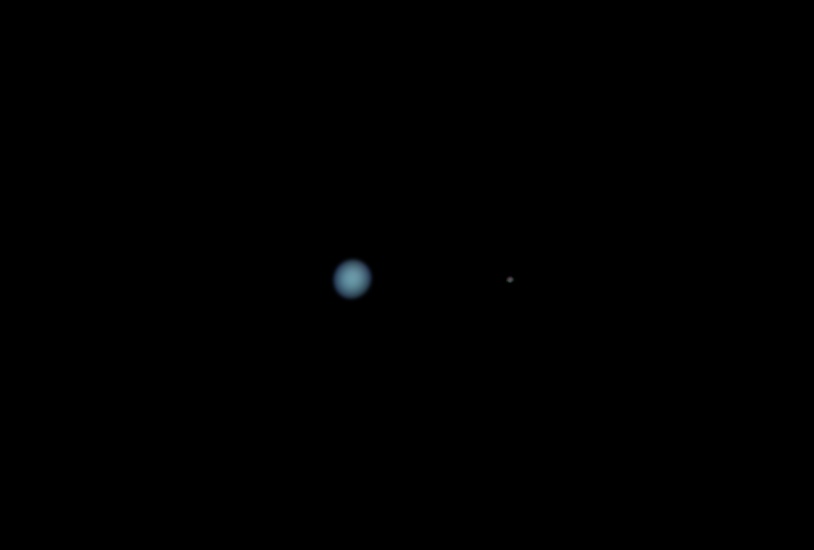
Neptune is a giant planet with a diameter of 49,500 km. (30,760 miles). Neptune has at least eight moons, six of which were discovered by the Voyger 2 space probe when it flew past Neptune in 1989. Neptune's largest moon is Triton with a diameter of 2,700 km. (1,680 miles). This image shows Triton to the right of the planet.
Triton is the coldest measured object in the solar system with a surface temperature of -235° C (-391° F). Although you would expect such a cold distant moon to be an inactive frozen body, the Voyger 2 space probe captured images of liquid nitrogen erupting from the surface of Triton as geysers spewing up into an extremely thin atmosphere with thin clouds of nitrogen ice particles. Triton circles Neptune in a retrograde direction, suggesting that Triton may be a Kuiper belt comet that was captured by the planet.
Neptune is the most distant planet from the Sun. (Of course, Pluto is farther away, but it is no longer considered to be a planet.) Neptune was discovered on September 23, 1846, by Johann Gottfried Galle, an astronomer at Berlin Observatory, and Louis d'Arrest, an astronomy student. Neptune's moon Triton was discovered by British astronomer William Lassell on October 10, 1846, less than a month after the discovery of Neptune. Prior to the discovery of Neptune, irregularities could be detected in the orbit of Uranus that appeared to be caused by another planet pulling and tugging on Uranus. Based upon the motions of Uranus, the probable position of the body perturbing Uranus' orbit was calculated mathematically, and Neptune was found at the predicted position.
A day on the planet Neptune lasts only 19.2 hours. However, a "year" on the planet Neptune (i.e., the time it takes to complete one orbit around the Sun), is equivalent to almost 165 Earth years. If you were born on Neptune, birthday celebrations would be few and far between! The Voyager 2 spacecraft captured images of a great dark spot on Neptune that was a storm system similar to the Great Red Spot on Jupiter.
This is an RGB composite CCD image taken with an FLI IMG6303e CCD on the Steward Observatory 61-inch Kuiper Telescope. The individual filtered images used to create this image were taken in a twilight sky that was rapidly getting brighter and brighter just before dawn. At the time this image was taken, Neptune was 2 arc-seconds in diameter and was 99.97 % illuminated. It was a magnitude 7.9 point of light in the eastern sky. This image was designated by Astronomy Magazine on their website as the "Picture of the Day" for June 2, 2007.
Constellation: Capricornus
RA: 21h 37m 57s Dec: -14d 24' 29"
May 24, 2007
Image by Sid Leach and Wil Milan
Mt. Bigelow, Arizona
Recent Images.
Complete list of images.
Description of equipment used to acquire images.
Home
Feedback and comments should go to Sid